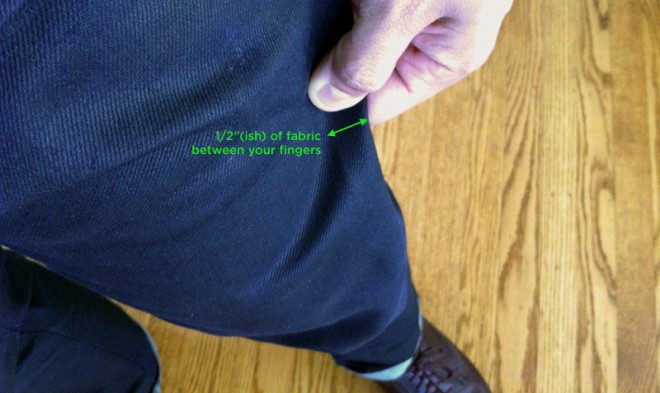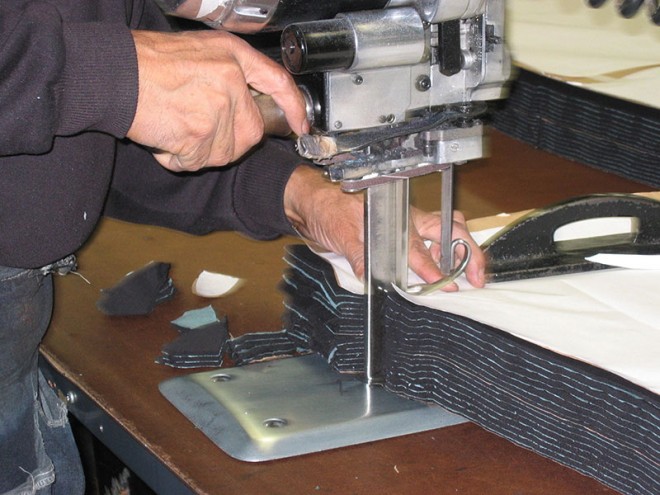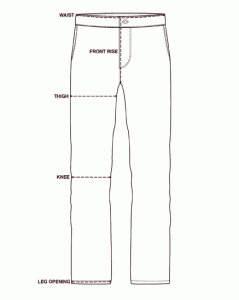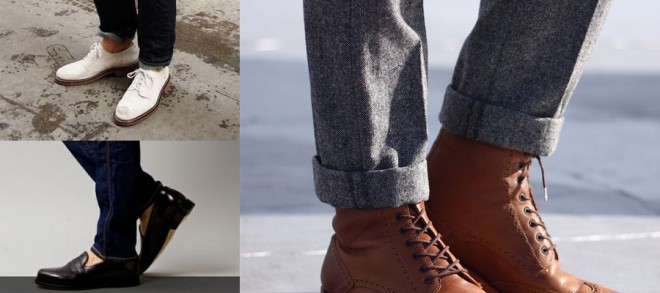Keep tabs on all fit articles: The Perfect Fit
How about we chat a bit about how causal pants for men should fit? I’m talking about your denim and chinos.
Those things you wear that aren’t part of a suit and aren’t shorts. You get what I’m sayin.
Let’s assume you’re not…
- a rapper from 1996
- an uber-trendy indie emo hipster scene kid from the Lower East Side
- an acid-washed denim connoisseur
- a proponent of always wearing black on black on black
Okay, let’s go.
General fit and cut
Your pants should fit slim, but not snug or uncomfortable. The outline of your package should not be showing. You want a well fitting pair of pants that hugs your legs and seat (aka, dat booty) while still giving you enough room to move and sit comfortably.

If you can pinch 1/2″ of fabric between your thumb and index finger from the thigh area (with your pants on), you should be good.
Waist
Casual pants for men should be able to fasten easily with no struggle. At the same time, you don’t want them so loose that they’re falling off your hips. Your size is what you feel most comfortable in within these boundaries.
Know that your size may not always be your size. It’s dependent upon the brand you’re buying, since much of today’s sizing is vanity. This basically means your 34″ pants may not be 34″ if you take out your tailor’s tape and measure it.
Take a look at this article from Esquire to see what I mean.
Not all sizes of the same brand and model fit the same!
Crazy, right?
I don’t mean to scare you or to overcomplicate things, but this is something you should be aware of. One size 34″ casual pants for men may fit differently, depending on the pair you choose off the rack, even if it happens to be the same model!
Let’s say you’re looking at a pair of Levi’s 501 in a size 34″. If you try three different pairs of Levi’s 501, there’s a chance they may all fit you slightly differently.

To some extent that’s unavoidable. When manufacturers are cutting the denim before constructing them into the final product, it is rolled out on a long table with one layer on top of the other. The fabric cutter then has to slice through all these layers, so when the cutter comes down and applies pressure, the fabric has a tendency to shift, thus the slight inconsistency in some sizes.
This isn’t anything you have to worry about. If you know your general size, you should be fine. The point is, when you’re out shopping for casual pants for men, make sure to try on several different sizes to hone in on your exact size, and then from there, try on a few versions of that size to make sure you have the perfect fitting pair.
Can’t tell the difference? Great! You’re all good then.
Rise
 The rise is defined as the measurement from the crotch seam to the top of the waistband. This can differ depending on whom you ask, but this seems to be the most common measurement method.
The rise is defined as the measurement from the crotch seam to the top of the waistband. This can differ depending on whom you ask, but this seems to be the most common measurement method.
Keep in mind that the measurement of the front rise will often be different from the back rise.
Why should you care? Other than the waist measurement, the rise determines how comfortable your pants feel when they’re on.
I personally like a rise between standard (mid) and low. Here are some general definitions:
- Low-rise: sits on or below your hips, a few inches below your belly button.
- Mid-rise: sits at the hips or a bit above, and much closer to your belly button. This front rise measurement is around 8-12″
- High-rise: anything that sits at your true waist and hits your belly button, if not covering it completely.
These are the general definitions, and just like waist measurements, can vary depending on the brand.
If I were you, I’d look for something in the low- to mid-rise range. You have to try on several styles and see what’s most comfortable. Everyone’s body shape is different, which means each person will need a different style of casual pants for men to accommodate his curves (or lack thereof).
For example (and using the Levi’s denim line to illustrate), if you’re a stick figure or have a small, trim, proportionate stature, you’d probably look great in a pair of 511 skinny denim, which features a slim leg and a lower rise.
If you have a bit more meat in your legs, you’d probably opt for a pair of 513 slim or 514 slim straight, which gives slightly more room in the thigh and seat, and a bit higher rise.
If you’re tall, meaty, and do a bunch of squats in the gym (or if you’re a fuller guy in general), you’d probably want to try a 501 Original or 505, which is the standard straight fit with an even higher rise (though it still sits below your waist, so you’re not all up in Dad Jean status).
See? It all depends. Finding the right pair for you means trying on a bunch of different styles of casual pants for men in the fitting room. Sucks, but you’ve gotta do it.
Pay attention and see what’s most comfortable AND what looks the best. Sure, 501 may be comfortable but if you’re 5’9″ and 125 lbs, you’ll be drowning in them. Plus you’ll be violating the rule of fit; keep it as slim and streamlined as possible, proportionate to your body shape.
By the way, rise doesn’t just apply to denim (even though I used denim as an example). Rise is something you need to pay attention to even when buying chinos, as brands make them with different rise measurements as well.
Length and break
For more traditional situations, you want a 1″ break for your chinos. To see this, take a look at the bend in front where the cuff hits the top part of your shoe. You shouldn’t see a large pooling of fabric down there, just a slight bend. Refer to my article about the appropriate break on EG if you need more info.
With a more traditional break, the back of your cuff should hit anywhere from the middle of the heel counter to the top of the heel.
For more casual situations, the length and break is more open to your preference. You may want them a little shorter with no break to show a peek of your socks and your whole shoe, or maybe you want them slightly longer so you can roll the cuff up.
If you want a normal pant length, simply follow the style mentioned above.
Leg opening
This is one of those things you may not think about. The style of the pants you choose usually determines the size of the leg opening.
Casual pants for men that are “straight fit” typically have one width measurement from the knee down. When you have a tapered fit, the pant leg tapers from the knee down, so the width measurement of your leg opening is smaller than the width at the knee. Bootcut pants are the opposite of that, as they get wider at the leg opening than they are at the knee.
If it were me, I’d choose a slim straight fit, or a fit with a slight taper. Again, this is all based on preference, but I personally like as minimal extra fabric as possible, so these would be my recommendations.
And please, stop wearing bootcut denim. Also, don’t bother justifying them to me, like, ever. I think it looks terribly dated and reminds me of 2004. You don’t need to wear them, even if you actually wear cowboy boots. For the most classic of looks, stick with a straight leg.
Bam!
You got this. You’re now officially equipped with all the information you need next time you go pants shopping. You’re welcome.
[Umit Benan, cutting fabric, pants measurement, cuffs: photo, photo, photo]
